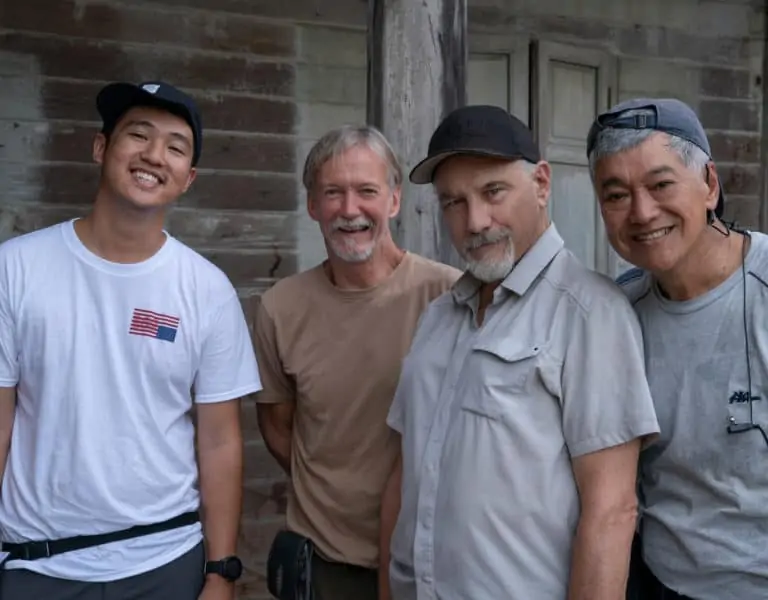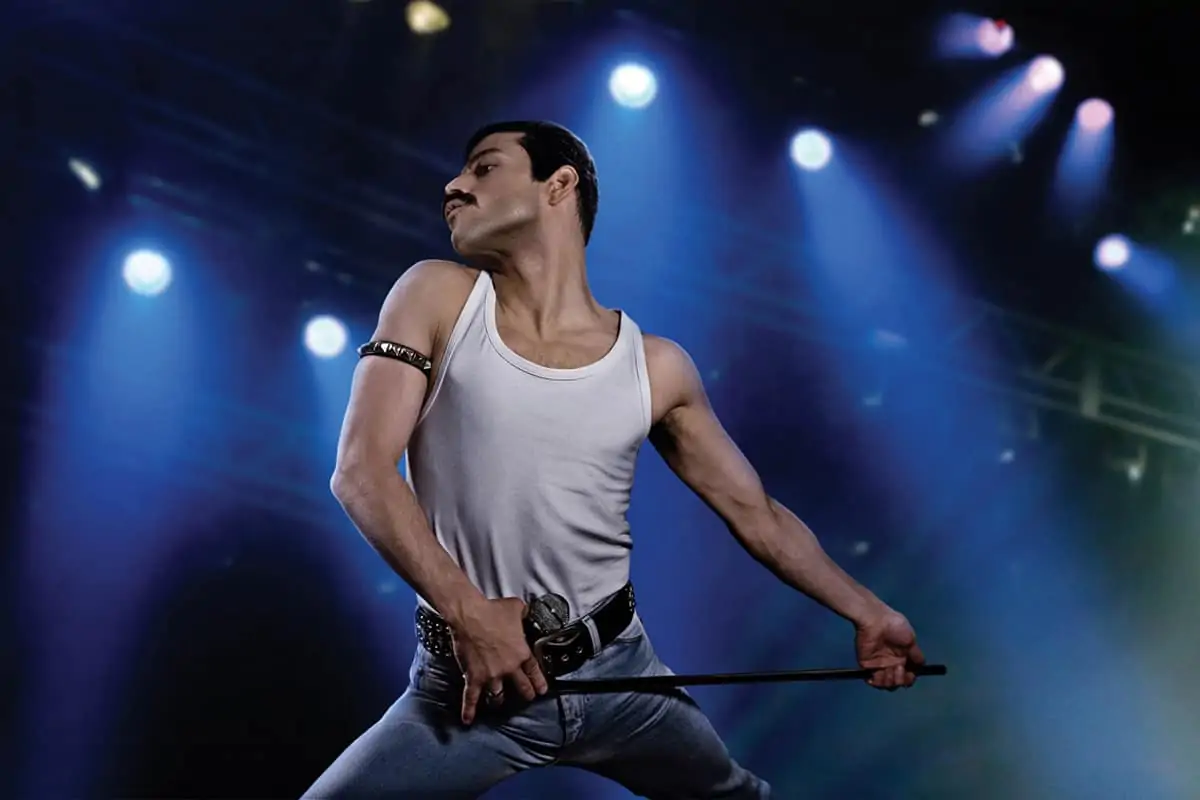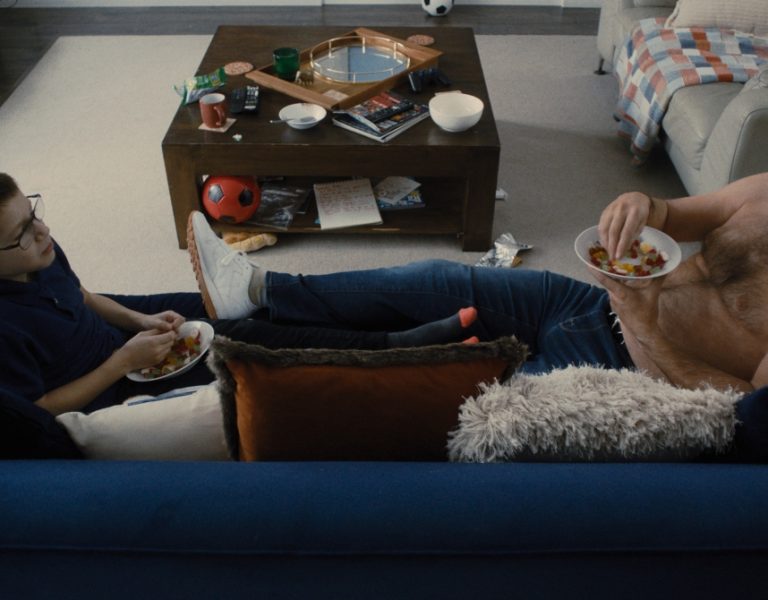INNER WARFARE
Newton Thomas Sigel ASC constructed a multitude of filmic tones to suit the wide-ranging chapters within Cherry, a hard-hitting and daring production combining crime thriller and love story with originality and impact.
First love, the unseen wounds of war, and downward spirals of self-destruction are examined in Cherry, a blend of emotions and life experiences masterfully captured for the screen. Fundamentally a character study, the multi-layered drama is also a commentary on the American opioid epidemic and potentially catastrophic effects of PTSD.
With an extensive list of dynamic and disparate credits to his name – Drive, The Usual Suspects, Bohemian Rhapsody, and Da 5 Bloods, to name but a few – cinematographer Newton Thomas Sigel ASC has once again crafted an original and immersive world in Cherry, a visual masterwork and product of a successful reunion with directing powerhouses Anthony and Joe Russo.
Based on the true-life story and debut novel of Nico Walker, the Apple TV+ drama tells the emotionally charged tale of a former army medic who returns from Iraq, haunted by war and with extreme undiagnosed PTSD, and becomes addicted to drugs. In pure desperation and to pay for the drugs that are destroying his life and that of his girlfriend Emily (Ciara Bravo), Cherry becomes a serial bank robber.
After teaming up with Sigel to make 2020 action thriller Extraction, the Russo brothers asked him to read Walker’s novel Cherry. “The book was very intense, powerful, and depressing. When I later read the screenplay (written by Angela Russo-Otstot and Jessica Goldberg) I thought the way it turned Nico’s unique voice and literary style into something cinematic that also gave the story a heart and an emotional resonance was wonderful.”
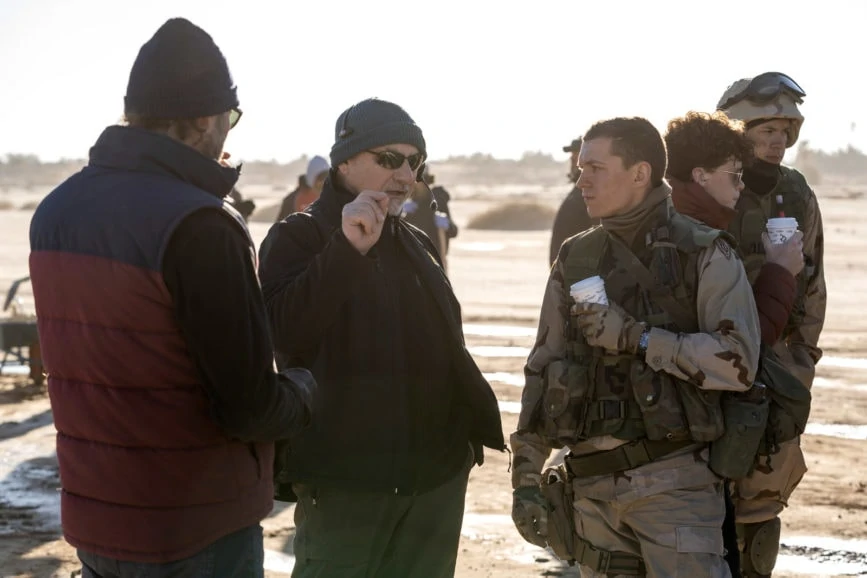
The screenplay and the Russos’ initial concepts for the film defined the story as being told in chapters – each one demanding its own visual language representing the journey of the protagonist Cherry (Tom Holland) over a 15-year period. “Anthony and Joe were interested in the issue of post-traumatic stress syndrome and how that fed into the opioid epidemic that is still raging all over the world, particularly in the United States,” says Sigel.
“Where they really went with it, even beyond the book, was trying to fashion a central character that is likeable on the one hand, and yet not idealised. He’s just a normal guy with his own anxieties who you see fall in love and follow all the way through his maturation and traumatisation in Iraq. For the Russos, this journey to hell and back of a young everyman was important, with each chapter marking another step in that voyage.”
What was exciting about Cherry and why, in many ways, it was the ideal creative endeavour, was that I was working for directors with a very strong creative vision and opinion, who also wanted mine.
Newton Thomas Sigel ASC
Sigel was encouraged to bring an energy and abundance of ideas and creative input to the table. “Yet it was very much in the service of the Russos’ already strong and bold vision for the movie. As a cinematographer, you work on some films where a director might need to be in control and has a very defined aesthetic. If they’re good directors that can be wonderful and you can grow a lot. And then there are those who are more about the performance and leave the visualisation more up to you. What was exciting about Cherry and why, in many ways, it was the ideal creative endeavour, was that I was working for directors with a very strong creative vision and opinion, who also wanted mine.
“Joe and Anthony constantly challenged me to think outside the box, to offer something beyond just getting a wide shot, some overs and some singles. They were not interested in a routine method of coverage, they wanted everything to have a very subjective point of view and to tell the story in a specific way.”
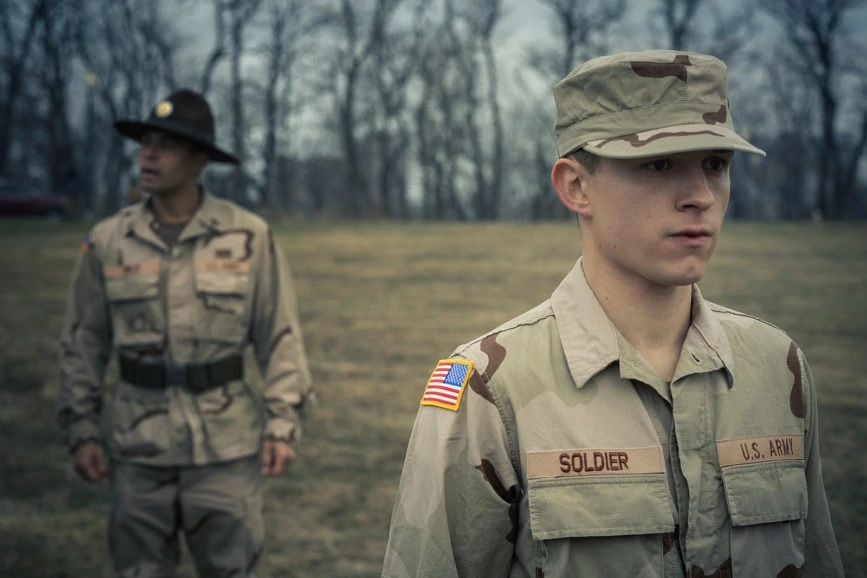
Each chapter had its own creative influence. The ‘Basic Training’ chapter, which sees Cherry train for the military, was heavily influenced by Stanley Kubrick’s Full Metal Jacket (1987). This part of the story needed to be wide in scope, with the environment the action plays out in as large and powerful as the war’s impact on Cherry. In a later chapter which sees Cherry return home from war – before he gets addicted to drugs but is unbalanced and struggling to transition back to civilian life – Sigel and the Russos drew on asymmetrical, unbalanced framing from productions such as Mr. Robot.
Each stage in Cherry’s journey was shaped in collaboration with production designer Phil Ivey, whose expertise had also been combined with Sigel’s during the making of Extraction. “The collaboration with Phil and costume designer Sara Sensoy was critical for Cherry as you’re also dependent on what they put in front of the lens. No matter what your lighting is like or how you alter the given environment, that relationship and ability to make sure you’re on the same page regarding how you want a scene to look is crucial, particularly for this film as we were working with many found locations rather than built sets due to the budget.”
The Cleveland-based portion of Cherry was filmed in Cleveland with scenes in Iraq shot in Morocco. Most of the Cleveland-based settings were practical locations apart from the set built for a scene in Cherry and Emily’s bedroom which required an “endless wall” effect. To adhere to the budget the exteriors of the ‘Basic Training’ chapter were shot at Cleveland’s Baldwin Water Treatment Plant. The interiors were filmed at the soon to be demolished St. Peter’s High School.
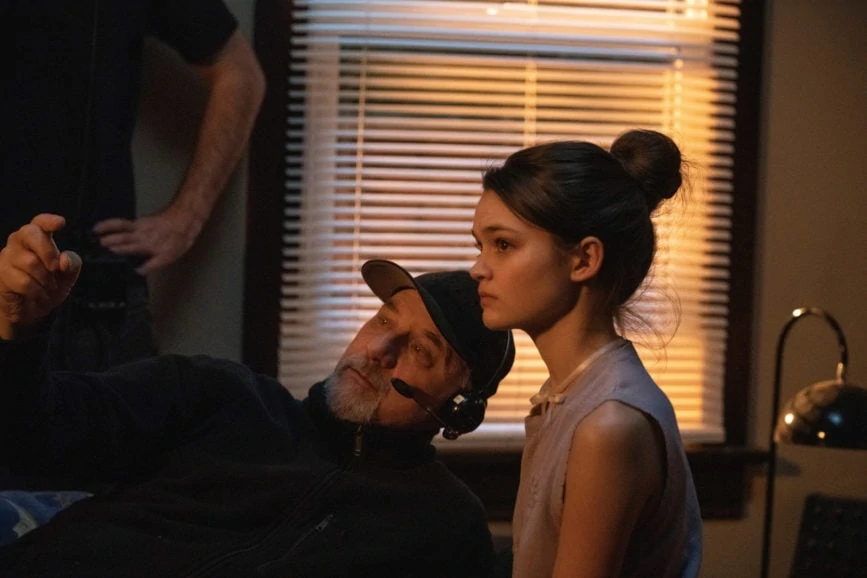
Locations such as Cherry’s home and workplace were easier to conceptualise because they were mostly drawn from the author’s life story. “Nico Walker really did go to war, return to Cleveland, get addicted to drugs and rob banks in Cleveland. Joe and Anthony are also from a neighbourhood in Cleveland not far from where Nico grew up which was helpful,” adds Sigel.
DESIGNING THE SHOTS
Sigel shot with the Sony Venice – “an incredible camera that was perfect for the production’s demands” – and a lens package dictated by each chapter’s look and feel. All scenes preceding ‘Basic Training’ and after Cherry returns from Iraq, were shot with anamorphic lenses, predominantly Todd AOvintagelenses. “The Todd AOs were created in the ‘50s and updated in the ‘70s and there aren’t many sets left. They have a very distinct look, a romantic quality of softness, and a real beauty that is hard to reproduce in any other lenses or in post,” says Sigel.
The cinematographer also worked with the Hawk Class-X, another anamorphic lens, but this time producing a “more modern, clean, and flat” look. The Class-X was predominantly used for scenes in which Cherry is the first-person narrator and refers to something outside of his experience. This subtle but distinct look is adopted in the final prison scenes. “When Cherry has gone into a real abyss of drug addiction and slowly works himself out of that hole over the course of 11 years, that had to be captured in a succinct montage for which the Hawk lens was ideal,” says Sigel.
‘Basic Training’ was shot using the 14mm Sigma spherical lens. This section of Cherry’s journey also sees the aspect ratio switch from 2.39 to 1.66, with the idea being that the combination of the wider lens and boxed-in square format would resonate with Cherry’s state of mind, his despondency at losing Emily and the realisation that his knee-jerk reaction to join the army is a choice he cannot go back on.
“The aspect ratio change was expressing that feeling of being trapped, but the wide lens means you are very close to the subject, so it feels like an intrusion of his private space. As much as you’re boxed in, this choice Cherry made is very much in your face, and there’s no going back. That section was designed with a relatively fixed camera in mind and we had to consider what the Sigma lens demanded in terms of blocking and how close people had to be to the camera,” explains Sigel. “When Cherry goes to Iraq, we switched to the Leica M System lens which is made for the small stills camera Leica developed and is frequently used by photojournalists. It’s a straightforward look, but with its own distinctive patina, and was a subtle nod towards documentary filmmaking.”
Handheld was used sparingly and only for specific moments in the story. “I have an interesting relationship with handheld – it’s my birthplace as I come from a documentary background, it’s what I grew up doing and it’s what I’d love to do, but I also feel it is sometimes used as a crutch to create an energy that really should be there in the story and performance. So, I tend to be relatively conservative about handheld, and save it for those scenes where the energy of the actors demands it.”
We tried to always have a very specific, singular perspective on any given scene. Nonetheless, the camera movement could range from the frantic quality of combat to the slower, ominous movement of drug life.
Newton Thomas Sigel ASC
Geoffrey Haley, who has worked with the Russos previously, once again excelled at camera operation. “He often does his handheld with a double-armed Sling Shot rig from Walter Klassen. Geoff is a fabulous partner in crime, who totally embraced a single-camera approach with more fluid shots that allow sequences to evolve,” says Sigel.
The cinematographer believes the film’s strength of voice came as a result of this single-camera approach, and helped to enhance the very subjective nature of the storytelling. “We tried to always have a very specific, singular perspective on any given scene. Nonetheless, the camera movement could range from the frantic quality of combat to the slower, ominous movement of drug life.
“One of my favourite examples of this is when Cherry carries a frail Emily upstairs in their house – it’s almost like he’s taking her to heaven. This was a subtle movement and all in one shot. To me that shot is emblematic of the movie. Another example is the camera movement in ‘Basic Training’ which was very minimal and dictated by the desire to use only the 14mm close to the subject. For the prison sequence, Joe and Anthony wanted a series of linear dolly shots all moving in the same direction and match cut. Years go by, and finally Cherry decides he will try to turn his life around. The camera does the same and changes direction – again in a series of match cuts describing his road to redemption.”
CONSCIOUS CREATIVE DECISIONS
Cherry takes the viewer on an emotional and sometimes harrowing journey, incorporating an arsenal of cinematographic techniques aligned with the tones of the scenes or characters’ experiences. That journey is accentuated by considered colour choice. When Cherry falls in love the visuals are warm, inviting, and romantic. When the film moves into the ‘Basic Training’ chapter a more neutral, cold aesthetic is adopted. “Cherry then visits Iraq, an exotic part of the world he’s never been before and it’s glowing, gold, and sand-coloured,” says Sigel. “When he returns home, it’s not as inviting as it should be. Although it begins a little warmer, blues start creeping into the picture as he becomes more addicted, with a lot of cyan in the shadow. In prison, there’s very little colour as it’s a lifeless environment.”
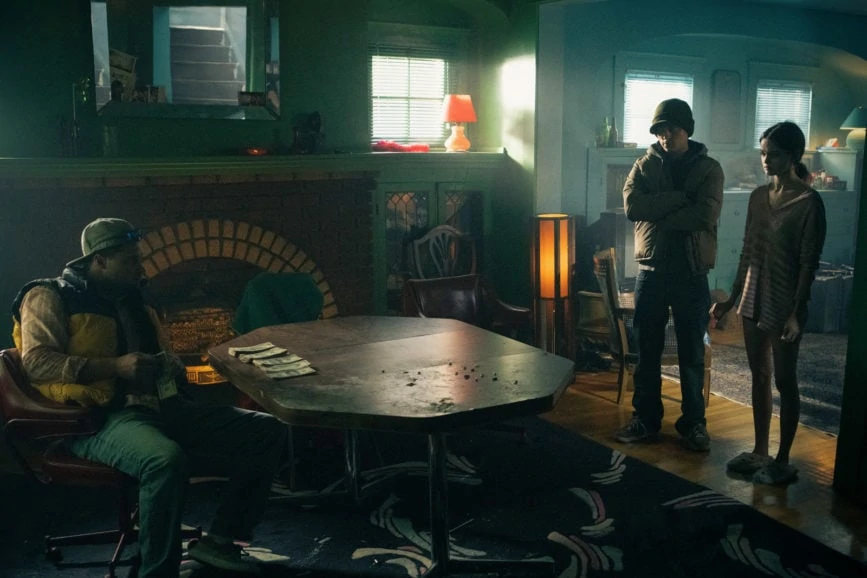
DIT Jason Bauer – a longtime friend of Sigel’s and “a wonderful collaborator” was also “integral to the final look of the film”. Cherry was finished with finesse by Company 3’s Stephen Scott. “I’ve known Steve for a long time and always wanted to work with him, so this was a wonderful opportunity and allowed us to achieve just the tone we wanted,” adds Sigel. “However, it was a challenge because we graded during COVID times and Steve was working remotely. It’s doable, more people will start doing it this way, and producers will tell you it works, but the remote approach is not my cup of tea.”
With the exception of the Iraq sequences’ more documentary feel, Cherry is predominantly shallow depth of field. “The film is so individual, subjective, and non-observational, and I really wanted to make focus a conscious creative decision in every shot. You don’t just take it for granted, you have to make a choice,” says Sigel.
For example, the identity of the unnerving and intimidating character Black is never revealed through clever use of focus, light, and shadow. “He was never really sharp or lit so you don’t get a good look at him. Focus is eccentric throughout the film and one of the great things about the Todd AO lenses is what they do to the out of focus areas, creating a texture unlike any lens I’ve seen.”
An early sequence featuring a teaser of what is to come later in the film as Cherry descends into a life of crime includes a lighting transition during a scene taking place in a bank and, after an intertitle, another lighting transition as Cherry first sees the love of his life.
“In the first scene, as the light dies away, only Cherry and the bank teller are lit. This then transitions to the moment he lays eyes on Emily in the classroom. She is angelically lit, with the rest of the students in shadow and barely visible. The light gently moves and as Cherry emerges from his trance, the light increases slightly so the other students and classroom are visible. This light transition was all part of the introduction to the idea that this will be a very subjective, internal, first-person film,” explains Sigel.
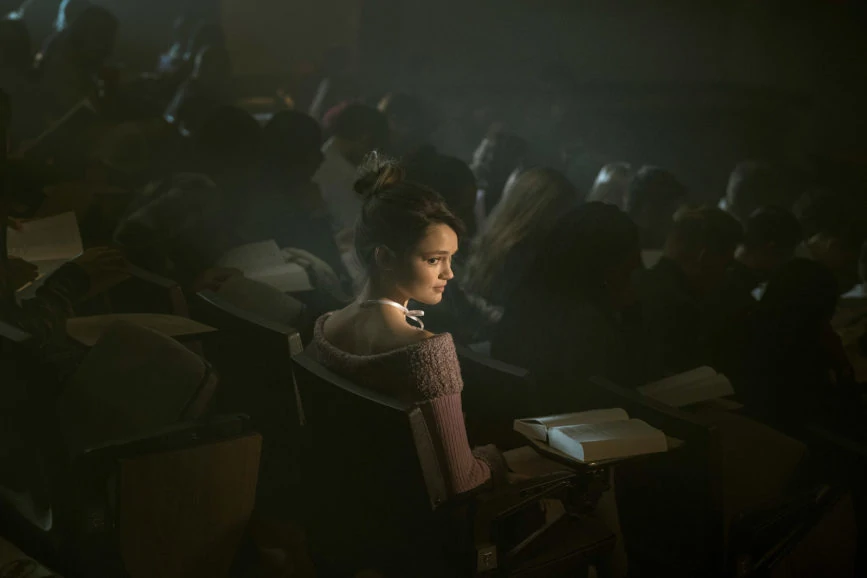
Like the character Black, the identity of the bank teller Cherry encounters is also initially concealed through creative lighting methods. “Two people at a counter in a bank – what could be easier? It was actually one of the trickiest scenes to light because you didn’t want the feeling the teller is standing in shadow. It needed to be unreal and feel like she was like a black hole Cherry could never connect with. A metaphor for his inability to find his place in the world.”
To achieve this effect Sigel removed all light from the teller, making her look like a shadowy, nonexistent figure, with Cherry and everything else around them naturally lit. The bank teller’s identity and pathos on her face are only revealed when Cherry returns to rob the bank.
A fan of natural and single-source lighting, Sigel’s lighting package for Cherry was small, partly dictated by budget. Predominantly LED fixtures were used to illuminate interior scenes – SkyPanels, LiteMats, Cream Source and units custom made by gaffer Bobby Krattiger. For projected sources, HMI units were used. “LED has revolutionised lighting at every level,” says Sigel. “I can have Bobby right by my side with dim control and work incredibly quick. He has a great eye and makes my job very painless.”
IT’S ALL ABOUT PERSPECTIVE
One of many inventive techniques explored throughout Cherry’s chapterssaw the filmmakers create a frozen-in-time effect for a scene in a restaurant, a rather different scenario to the time-freeze sequences Sigel shot for action sci-fi X-Men: Days of Future Past (2014). “It was Joe and Anthony’s suggestion to create this effect in Cherry. What I loved was there were no superpowers involved – it was a subjective way to express what is going on in Cherry’s head. The effect is very simple to create – you tell people to freeze and then tell them to move, with the best results achieved when somebody is ‘frozen’ in the middle of a physical action – like pouring a drink or reaching for an object. It’s one of my favourite scenes in the movie – simply done, totally lo-fi, but psychologically effective.”
The whole vibe and way you respond to the material is different. It’s not just about using a wide lens, it’s where that lens is looking. Film is all about point of view, whether first-person, third-person, or alien.
Newton Thomas Sigel ASC
Elsewhere, unusual and unbalanced composition produced an unsettling feeling in a scene when Cherry is prescribed opioid medication Oxycontin. A scene can be made more disquieting by framing it so the viewer cannot quite see the eyes of the person talking or perhaps only one eye can be seen but it is too close to the camera, explains Sigel. “The whole vibe and way you respond to the material is different. It’s not just about using a wide lens, it’s where that lens is looking. Film is all about point of view, whether first-person, third-person, or alien.”
To add impact and an almost hallucinogenic feeling to another stage in Cherry’s downward spiral, Sigel used an ambitious top shot, expressing the idea they are sinking into a rabbit hole of no return. When Cherry returns from war and is struggling to cope and becomes addicted to drugs, he starts to drag Emily down with him. After initially resisting, she begins to succumb during a dialogue scene between her and Cherry in bed which transitions into the ‘Dope Life’ chapter.
“I asked for the bedroom set to be built so we could take the walls all the way to the top of the warehouse we were filming in,” says Sigel. “We then used a relatively straightforward crane movement. As it moves up and up, it initially has the feeling of a scene ending, but the camera doesn’t stop where you would expect the ceiling to be. The surreal quality of it really makes it feel like Cherry and Emily are sinking into an abyss.”
Some of the film’s crucial introductory sequences were captured from an aerial perspective – a scene presenting principal character Cherry and a sequence depicting Cherry’s first time in battle in Iraq. While helicopters were used for certain shots such as air-to-air footage of other aircraft in Iraq, drones were essential for other elements of the storytelling.
“There are some things you can film with a drone that you just can’t capture any other way. I’m sort of infatuated by how you introduce your principal characters, and so much of this film is about Cherry, his community, and the environment in which he’s growing up, which is how we started the movie,” says Sigel. “Yet, when you first see Cherry, you actually see him at his worst, right before his final bank robbery. So, we started with an aerial wide shot over the tree line, looking at the community he lives in and a view of this very middle America, generic, suburban neighbourhood. The camera flies over the street to Cherry’s house and as he emerges, we move into a close-up.”
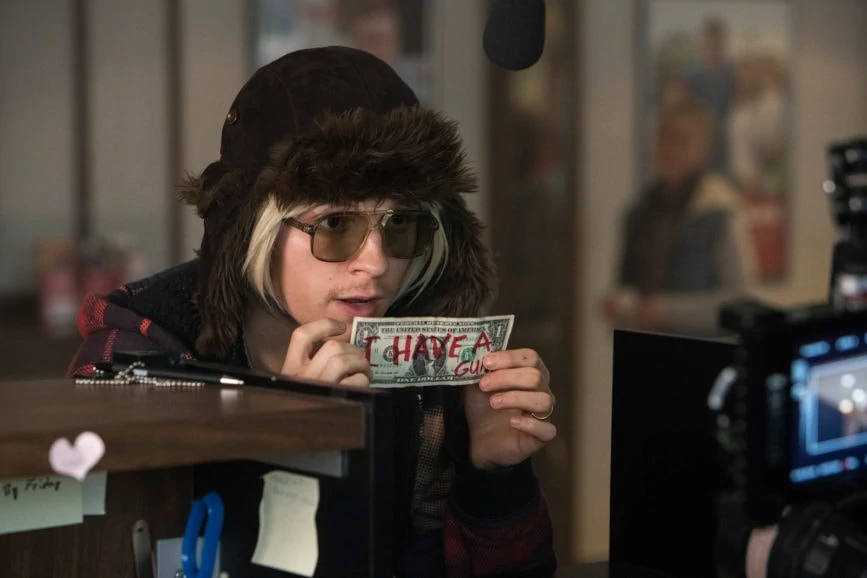
Instead of stitching shots together, this sequence was filmed with a single drone shot. This involved flying the drone over the street and precisely timing when Tom Holland would exit his house. At this point camera operator Geoffrey Haley grabbed onto the drone and directed it towards Holland’s face.
Likewise, a drone sequence was chosen to capture Cherry’s introduction to war in Iraq, an experience that quickly escalates into trial by fire. Sigel and the crew designed a way to take the scene from grand carnage and a landscape of death and destruction right into the mind of Cherry. “The shot begins over the hills, moving over insurgents shooting down on a destroyed convoy of military trucks. The American soldiers fire back as bombs explode, and the camera sweeps all the way down to two soldiers hiding behind a vehicle. There’s a brief exchange, and then one of them runs toward the back end of the convoy that’s under fire.”
For the last segment of the shot, as the drone passed camera operator Greg Baldi,who had earlier been in shot firing an M16 gun, he dropped his weapon and held onto the drone, moving it toward the two soldiers who are having a conversation. Baldi moved with them for a few steps and then released the drone, allowing it to follow the soldiers back to the convoy where the horrific sight of burning dead bodies is revealed.
“At that point, when the camera passed another Humvee, Geoff Haley, dressed as a soldier, jumped up, ran after the drone, just as the second convoy which Cherry is in appeared over the crest of the hill and screeched to a stop. As Cherry jumped out of the truck, Geoff grabbed the drone and moved it right into Cherry’s face. This scene goes from this huge wide shot into a powerful close-up and the sergeant coming into the frame and shaking Cherry to make him snap back to reality. That’s Cherry’s intense introduction to war.”
At the other end of the scale, a sense of the community Cherry is part of in his hometown, before his life descends into chaos, was communicated through camera movement in a sequence which introduces his friends with a single shot, all filmed from inside the car. This shot gives the viewer an idea of the kind of person Cherry is, his friends, and the fabric of the world he’s growing up in. “He describes each friend in turn, allowing the shot to evolve. Rather than cutting to each character, one by one, you see his friends get in the car and meet the four principal characters in one shot. The scene also takes you through an argument, you hear the friends fighting energetically and then it lands on Cherry, who doesn’t say anything. It’s an observational moment for him and in essence that whole beginning is his point of view – he’s telling you about his friends and we see them from his perspective, as a viewer, not a participant.
“A great camera team helped capture moments such as these, including A camera operator Geoff Haley, 1st AC Dan Schroer, and key grip Jim Shelton. It was my first time working with Jim. He’s so inventive. When I would say things like, ‘I want to put the camera in the middle of a car and turn 360-degrees,’ he would just help you figure it out. Without that crew, Cherry would not have looked the way it does. And all that hard work from the entire team really pays off when the lead – in this case Tom Holland – tells you he just saw the final cut of the movie and was amazed by how incredible it looks. As a filmmaker, you can’t really ask for anything more.”




